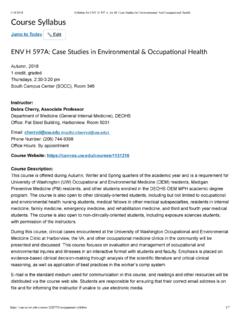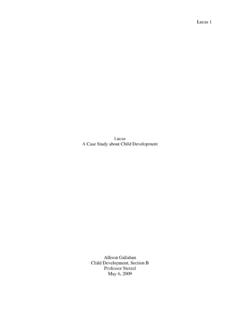Transcription of Case Studies - Harvard Medical School
1 case Studies case Study 1: A Pain in the Knee Principles of Pharmacology 2002 case 1:1 case Author: John D. Yee, , HMS 91 case Editors: Kelly Fuksa, HMS 04 and Prasanna Jagannathan, HMS 04 case Study 1: A Pain in the Knee David Robertson is a 15 year old high School student from the Bronx, New York City, who presents to the ER in February 1998 with a complaint of dull, aching pain in his left knee for the past month. David is a track athlete on his high School team, and reports accidentally tripping and falling on his left leg during practice about the same time the pain began. He lives with his mother and two younger siblings. In addition to attending high School , he works at the local supermarket to help support his family.
2 He says that his leg pain has been interfering with his ability to concentrate in School and to have a good social life. He admits to experimenting with alcohol, marijuana, and heroin at parties, but emphasizes that he is not an addict. David s past Medical history is unremarkable; he has never been hospitalized. His family history is positive for hypertension and alcoholism on his mother s side. The physical exam is notable for tenderness in the left knee. The knee is slightly swollen, and there is a decrease in the range of motion of the left leg. A radiograph is taken, revealing a left proximal tibial mass. A tentative diagnosis is made, and David is referred to Dr. Hardiman, an orthopedic surgeon at New York Presbyterian Hospital, for a definitive biopsy.
3 The biopsy is done in March 1998, confirming the diagnosis of osteosarcoma. Dr. Hardiman discusses the nature of this cancer with David and his parents, and recommends an above the knee amputation. David refuses to consider this option, and asks for a second opinion. Dr. Hardiman refers David to Dr. Ramirez at Mt. Sinai Hospital. Dr. Ramirez offers to try a new limb salvage procedure involving a total knee replacement and the placement of an expandable metal rod after resection of the tibial tumor. Dr. Ramirez informs David that the operation is long (8-10 hours) and painful. After lengthy discussions with David and his mother, Dr. Ramirez schedules the surgery for April 1998.
4 On the night before surgery, Dr. Chang, an anesthesiologist, comes by David s room to examine him. She considers David s history of drug use, her physical exam, and the nature of the operation as she develops an anesthetic plan. David is given Valium (diazepam), 5 mg po, the night before his operation. Two hours before the operation, he is given an additional 10 mg of Valium. In the OR, David is hooked up to several monitors: an automatic blood pressure cuff, an EKG, and a pulse oximeter. The anesthesia is induced intravenously with propofol and morphine. After the endotracheal tube is placed, inhalational anesthesia is begun with isoflurane and nitrous oxide in oxygen. Pancuronium, a muscle relaxant, is given prior to the incision, and additional doses are given every 1-2 hours throughout the operation when the neuromuscular stimulator placed on the ulnar nerve produces a noticeable twitch response.
5 The operation proceeds without complication, and 20 minutes before the end of the procedure the isoflurane is discontinued. As the surgeons complete the procedure, reversal of paralysis is accomplished by intravenous doses of neostigmine and atropine. In the recovery room David is groggy, but he begins to notice the pain in his left leg. Dr. Chang writes an order in the chart for pain control in the recovery room and a separate order for pain control on the ward. She considers various drugs, routes of administration, and dosing regimens. She keeps in mind that, although one-to-one nursing is available in the recovery room, the staffing is less intensive on the ward floors. In the recovery room, morphine sulfate, mg/kg, is administered in intravenous boluses until David is comfortable.
6 He is monitored every 15 minutes, not only for pain but also for respiratory rate, blood pressure, and pulse. On the floor, David is given morphine sulfate, mg/kg, intramuscularly every 4 hours. He is in considerable pain near the end of each 4-hour period, so the dosing regimen is changed. On the tenth post-operative day, David is discharged home with a 7-day supply of Percocet (oxycodone, 5 mg, and acetaminophen, 325 mg) at a recommended dose of 2 tablets 3-4 times a day for pain control. He is also given instructions to begin outpatient physical therapy. He does very well over the ensuing months as he adapts to the metal prosthesis. He experiences occasional episodes of pain in his left leg, which are usually responsive to Tylenol #3 (codeine phosphate, 30 mg, and acetaminophen, 300 mg).
7 By July, 1998, however, David returns to his oncologist requesting stronger medication for his increasingly frequent pain, as the Tylenol #3 no longer gives him relief. The oncologist, concerned about David's history of drug use and potential for addiction, decides to refill his prescription for Tylenol #3 and to tell David to sign up for a stress reduction/wellness class at the hospital. David's pain becomes more intense. He seeks out another oncologist, Dr. Clark, who prescribes Percocet at a dose of 8-10 tablets/day. David and his mother take the prescription to their local pharmacy, but are told, We don't stock Percocet here. You will need to try some other store. After three days, they are finally able to find a pharmacy an hour away from their home that is able to fill the prescription.
8 The Percocet provides much better pain relief for David than the Tylenol #3. He notices, however, that he needs to increase the number of Percocet tablets he must take in order to get the same relief. By October 1998, the amount has increased to 20-25 tablets/day. In addition, he often wakes up in severe pain in the morning, and takes several Percocet to get on top of the pain. David and Dr. Clark begin to have frequent disagreements about his opiate analgesic prescription. In February 1999, David is referred by his oncologist to Dr. Fish of the New York University Pain Management Center. On his initial visit, David is quiet and sullen. He admits that he is no longer as sociable as he was prior to his illness; he has not gone on a date since his discharge and he no longer spends time with his friends.
9 He has missed three semesters of School because of his illness, stating that he plans to catch up slowly rather than rushing to graduate with his class. David experiences a constant dull pain (5 on a scale of 1 to 10), with occasional sharp shooting pains along the scar line. He notes an area of numbness on the anterior side of his left lower leg surrounded by an area of strange dysesthetic pain. Radiologic Studies show no recurrence of the osteosarcoma. Dr. Fish makes a diagnosis of chronic neuropathic deafferentation pain secondary to nerve trauma related to the surgery. Dr. Fish develops a multidisciplinary plan including referral to physical therapy for a transcutaneous electrical nerve stimulator (TENS unit), referral to behavioral medicine for relaxation and biofeedback training, and prescriptions for amitriptyline, 25 mg po qhs, and Percocet, 2 tablets 4 times a day as needed for pain.
10 Although Dr. Fish refuses to increase the amount of Percocet prescribed, David continues to get a separate prescription for Percocet from Dr. Clark. In October 1999, he is still taking 20-25 tablets every day. Dr. Fish decides to admit David to the hospital for a lumbar sympathetic and epidural block with local anesthetics while tapering him off the opiate analgesics. He tells David that this will involve placing into his back 2 very fine flexible catheters that will remain in place for the 7-day hospitalization. As the pain is controlled by the lumbar and epidural blocks, the Percocet dose will gradually be decreased. Under light anesthesia, indwelling catheters are placed with fluoroscopic guidance into the epidural space and at the left lumbar sympathetic chain at the level of L3.









